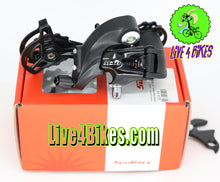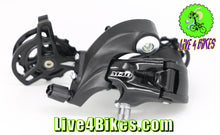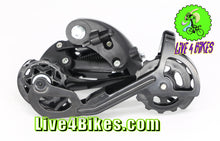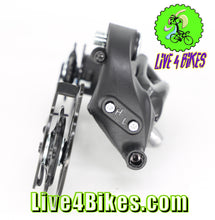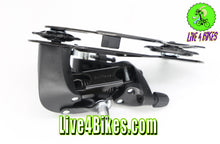
Introduction
In the world of cycling, the rear derailleur plays a critical role in shifting gears smoothly and efficiently. One notable contender in the 7-speed rear derailleur arena is the Sun Race M41. Offering a 7-speed, 11-34t gear range and equipped with a long cage, the M41 is designed to handle a variety of terrains. Notably, it's compatible with Shimano components and stands as a strong competitor to the Shimano Altus.
The SunRace M41: Key Features
1. **Gear Range**:
- The Sun Race M41 offers a 7-speed gear range, which refers to the number of cogs on the rear cassette. This range is suitable for a diverse set of riding conditions, from flats to moderate inclines.
2. **Cassette Compatibility**:
- The M41 is compatible with an 11-34t cassette, meaning it can accommodate a wide range of gear ratios. This versatility makes it an excellent choice for riders who face varying terrains.
3. **Long Cage Design**:
- The long cage design of the M41 provides the capacity to handle a wide range of gear sizes. This is particularly beneficial when navigating steep inclines, as it allows for smoother transitions between gears.
4. **Shimano Compatibility**:
- One of the standout features of the M41 is its compatibility with Shimano components. This ensures that riders can easily integrate the M41 into their existing Shimano drivetrain setups without compatibility issues.
5. **Build Quality**:
- Constructed with durable materials, the Sun Race M41 is designed to withstand the rigors of off-road cycling. Its robust construction ensures longevity and reliable performance even in challenging conditions.
Sun Race M41 vs. Shimano Altus
The Sun Race M41 is often compared to the Shimano Altus due to their similar specifications and price range. Both offer 7-speed setups with an 11-34t capacity and are suitable for a range of riding conditions. However, the M41's compatibility with Shimano components makes it a compelling alternative for riders seeking a seamless integration with their existing drivetrain.
Installation and Maintenance
Installing the Sun Race M41 is relatively straightforward for those with basic mechanical skills. However, it is recommended to seek professional assistance if you are unfamiliar with derailleur installation.
In terms of maintenance, regular cleaning and lubrication are essential to ensure smooth and efficient shifting performance. Periodic checks for wear and tear on the jockey wheels and pulleys are also recommended.
Conclusion
The Sun Race M41 7-speed rear derailleur is a versatile component suitable for a wide range of riding conditions. With its 11-34t gear range, long cage design, and compatibility with Shimano components, it stands as a strong competitor to the Shimano Altus. Its durability and reliable performance make it an excellent choice for cyclists seeking a cost-effective and dependable rear derailleur option.
Whether you're tackling steep inclines or cruising on flat terrain, the Sun Race M41 is poised to deliver consistent and efficient gear changes, enhancing your overall cycling experience.

Specifications


Choosing the Right Bicycle Derailleur: A Comprehensive Guide
Bicycle derailleurs are crucial components that facilitate smooth gear shifting, allowing cyclists to adapt to varying terrains and conditions. Selecting the correct derailleur for your bike is essential for optimal performance and longevity. In this article, we'll delve into the key considerations when choosing a derailleur, including compatibility, gear matching, and brand options.
Compatibility: Shimano vs. SRAM
One of the most critical factors when choosing a derailleur is brand compatibility. Shimano and SRAM, two of the most prominent bicycle component manufacturers, use different derailleur designs and shifting technologies, making them generally incompatible. Attempting to mix these brands can lead to poor shifting performance, potential damage, and safety risks. Therefore, it's crucial to stick with one brand throughout your drivetrain system.
Shimano, Sunrace, and Suntour: Compatible Choices
On the other hand, Shimano, Sunrace, and Suntour derailleurs are generally compatible with one another. This means you have more flexibility in choosing components within this group. You can mix and match derailleurs, shifters, and cassettes from these brands to create a drivetrain that suits your riding style and preferences.
The Importance of Matching Gears
Matching the number of gears between your derailleur, shifter, and cassette is vital for smooth and reliable shifting. For example, if you have an 11-speed cassette, you should use an 11-speed shifter and derailleur. Mismatching gears can lead to poor shifting performance, potential damage to the components, and an overall unsatisfactory riding experience.

Factors to Consider When Choosing a Derailleur
1. Speed Compatibility**: Ensure that the derailleur is compatible with the number of gears on your cassette. Common options include 7, 8, 9, 10, 11, and 12-speed systems.
2. Mounting Type**: There are two main types of derailleurs - braze-on and clamp. Braze-on derailleurs attach directly to a mount on the frame, while clamp-style derailleurs attach around the seat tube using a band clamp.
3. Cage Length: Derailleurs come in short, medium, and long cage lengths. Short cages are suitable for road bikes and provide crisper shifting on flat terrain, while medium and long cages are designed for mountain bikes and accommodate a wider range of gears.
4. Max Cassette Size: Ensure that the derailleur can accommodate the largest cog on your cassette. This is especially important for mountain bikes, as they often have larger cassettes to tackle steep climbs.
5. Brand Compatibility: Stick with a single brand for all your drivetrain components to ensure optimal compatibility and performance.
Selecting the right derailleur for your bicycle is crucial for a smooth and efficient riding experience. Pay close attention to compatibility between brands, make sure the number of gears matches across components, and consider factors like cage length and cassette size. By taking these considerations into account, you can enjoy a reliable and high-performing drivetrain that suits your riding style and needs.


Upgrading your bicycle's derailleur can greatly improve its performance and extend its lifespan. However, it's crucial to do this correctly to ensure compatibility with your existing components. In this guide, we'll walk you through the process of upgrading your bicycle derailleur, covering essential considerations and steps.
Things to Consider Before Upgrading
1. Compatibility**:
- Ensure that the new derailleur is compatible with your bike's drivetrain. Consider factors like speed (e.g., 7-speed, 9-speed, 10-speed) and brand compatibility.
2. Mounting Type:
- Determine if your bike uses a direct mount derailleur or one that attaches to a derailleur hanger. This affects the type of derailleur you need to purchase.
3. Cable Pull Ratio:
- Match the cable pull ratio of the new derailleur with the old one. This ratio dictates how much the derailleur moves for a given amount of cable pull.
4. Cassette and Chain Compatibility:
- Ensure that your new derailleur can handle your cassette's range and that it's compatible with your chain. Different speed cassettes may require specific derailleurs.
5. Derailleur Cage Length:
- Choose the correct cage length based on your cassette size. Short cages are suitable for smaller cassettes, while long cages accommodate larger ones.
6. Tools:
- Gather necessary tools, including Allen wrenches, a cable cutter, a chain tool, and a derailleur hanger alignment tool (if needed).

Step-by-Step Guide
1. Prepare Your Bike:
- Clean the drivetrain and surrounding areas to ensure a smooth installation process.
2. Remove the Old Derailleur:
- Shift the chain onto the smallest chainring and smallest rear cog.
- Use an Allen wrench to remove the derailleur from the derailleur hanger or mount.
3. Install the New Derailleur:
- Attach the new derailleur to the hanger or mount. Ensure it's aligned properly.
4. Adjust the H-Limits:
- Set the high (H) and low (L) limit screws to prevent the chain from falling off. Use the barrel adjuster to fine-tune.
5. Install the Chain:
- If you're replacing the chain, feed it through the derailleur and use a chain tool to connect the ends.
6. Set the Cable Tension:
- Attach the cable to the derailleur, ensuring it's properly seated in the pinch bolt. Pull the cable tight and secure it.
7. Fine-Tune Shifting:
- Shift through all gears to ensure smooth transitions. Adjust the barrel adjuster as needed.
8. Check Derailleur Alignment:
- Use a derailleur hanger alignment tool to verify that the hanger is straight. Misalignment can cause shifting issues.
9. Test Ride and Make Further Adjustments:
- Take your bike for a short ride, testing shifting under load. If necessary, make additional adjustments to achieve optimal performance.
Upgrading your bicycle's derailleur can significantly enhance your riding experience. By considering compatibility, using the right tools, and following these steps, you can ensure a smooth and successful upgrade. Remember to take your time, double-check all connections, and test thoroughly before hitting the road. Enjoy the improved performance of your upgraded derailleur!






